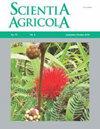Foliar application of graphene oxide, Fe, and Zn on Artemisia dracunculus L. under salinity
IF 2.6
3区 农林科学
Q1 Agricultural and Biological Sciences
引用次数: 3
Abstract
: Salinity is an abiotic stressor that greatly influences crop growth and yield. Scientists are always exploring diverse methods to combat salinity depression. Here, we conducted a greenhouse experiment to study the effects of NaCl salinity (0, 50, and 100 mM) under the foliar spray with zinc-oxide, nano zinc-oxide, iron-chelate, magnetized-Fe, and graphene-oxide on tarragon. The results revealed that the treatment with foliar spray of graphene showed the highest K + /Na + . Salinity of 50 and 100 mM × all foliar applications increased superoxide dismutase activity, whereas 100 mM NaCl raised the malondialdehyde content to its highest level. All salinity levels × Zn foliar spray improved the catalase activity. The foliar spray and salinity experiment exposed to Zn-treated plants attained the highest contents of essential oils. Proline and total phenolics showed the greatest amounts with 50 and 100 mM of NaCl, respectively. The GC/MS analysis revealed 38 compounds in the oil of Artemisia dracunculus L. as estragole (81-91.8 %) was the most dominant constituent. The highest amounts of estragole were found at 50 and 100 mM NaCl foliar sprayed with ZnO. Cis-Ocimene (0.1-6.4 %) was another major constituent with a high variation between the treatments. The highest cis-ocimene content was recorded at 100 mM NaCl × foliar Fe-chelated and in the graphene treatment. Overall, salinity adversely affected the physiological responses of tarragon; however, foliar spray with both forms of Fe and Zn partially ameliorated the adverse salinity effects.盐胁迫下氧化石墨烯、铁和锌在龙珠蒿叶面的施用
本文章由计算机程序翻译,如有差异,请以英文原文为准。
求助全文
约1分钟内获得全文
求助全文
来源期刊

Scientia Agricola
农林科学-农业综合
CiteScore
5.10
自引率
3.80%
发文量
78
审稿时长
18-36 weeks
期刊介绍:
Scientia Agricola is a journal of the University of São Paulo edited at the Luiz de Queiroz campus in Piracicaba, a city in São Paulo state, southeastern Brazil. Scientia Agricola publishes original articles which contribute to the advancement of the agricultural, environmental and biological sciences.
 求助内容:
求助内容: 应助结果提醒方式:
应助结果提醒方式:


